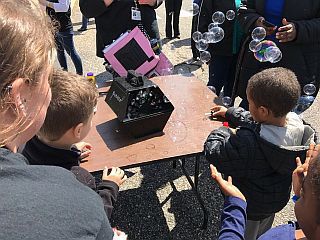Since April is National Autism Awareness Month, Cape May City Elementary School students blew bubbles April 12 to heighten student awareness.
Autism Impact in County
To substantiate what impact autism has on students, families, and schools, Cape May County Special Services School District Superintendent Barbara Makoski, gave the following update to freeholders March 28 while making an annual presentation to the Board of School Estimate at the Cape May County Administration Building:
“We have more students with Autism and increased numbers of students with disabling behaviors that inhibit their ability to be educated with non-disabled peers.
“For example, in the 2009-10 school year, my district had six Autism classes: one preschool class, four elementary and one high school class.
“We currently have 10 Autism classes: one full-day preschool class, six elementary classes in Ocean Academy, and three high school classes.
“Some of the students with Autism who have very difficult, and many times, very aggressive behaviors are being educated within our school to the greatest extent possible. New Jersey Administrative Code determines the class sizes and age ranges for students with disabilities, and for students with Autism, there is a very low student to staff ratio.
“For example, an elementary autism class is only permitted to have six students in it. We have to continually monitor the number and ages of students needing Autism programming and the personnel needed to meet those needs. The increase requested from the county within this budget is to provide a classroom aide in the Autism program.”
What is Autism?
The following is from the website of the Autism Society.
Autism spectrum disorder (ASD) is a complex developmental disability; signs typically appear during early childhood and affect a person’s ability to communicate, and interact with others.
ASD is defined by a certain set of behaviors and is a “spectrum condition” that affects individuals differently and to varying degrees. There is no known single cause of autism, but increased awareness and early diagnosis/intervention and access to appropriate services/supports lead to significantly improved outcomes.
Some of the behaviors associated with autism include delayed learning of language; difficulty making eye contact or holding a conversation; difficulty with executive functioning, which relates to reasoning and planning; narrow, intense interests; poor motor skills’ and sensory sensitivities.
Again, a person on the spectrum might follow many of these behaviors or just a few, or many others besides. The diagnosis of autism spectrum disorder is applied based on analysis of all behaviors and their severity.
In 2016, the Centers for Disease Control and Prevention issued their ADDM autism prevalence report. The report concluded that the prevalence of autism had risen to one in every 68 births in the United States – nearly twice as great as the 2004 rate of 1 in 125 – and almost one in 54 boys.
The spotlight shining on autism as a result has opened opportunities for the nation to consider how to serve families facing a lifetime of supports for their children.
In June 2014, researchers estimated the lifetime cost of caring for a child with autism is as great as $2.4 million. The Autism Society estimates that the United States is facing almost $90 billion annually in costs for autism.
(This figure includes research, insurance costs and non-covered expenses, Medicaid waivers for autism, educational spending, housing, transportation, employment, related therapeutic services and caregiver costs.)
The Signs: Early Identification Can Change Lives
Autism is treatable. Children do not “outgrow” autism, but studies show that early diagnosis and intervention lead to significantly improved outcomes. For more information on developmental milestones, visit the CDC’s “Know the Signs. Act Early” site.
Here are some signs to look for in the children in your life:
- Lack of or delay in spoken language
- Repetitive use of language and/or motor mannerisms (e.g., hand-flapping, twirling objects)
- Little or no eye contact
- Lack of interest in peer relationships
- Lack of spontaneous or make-believe play
- Persistent fixation on parts of objects








